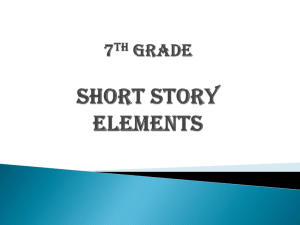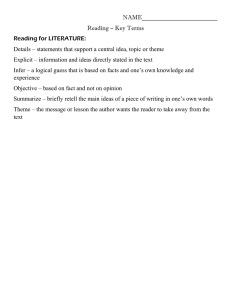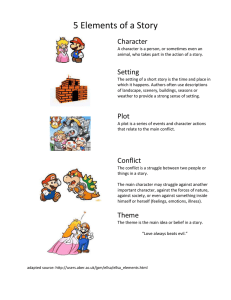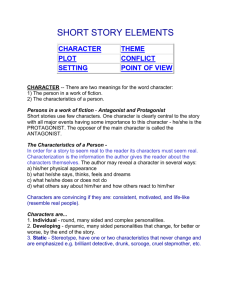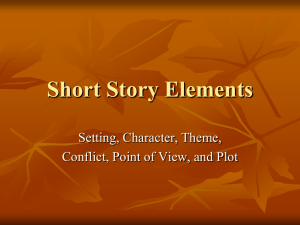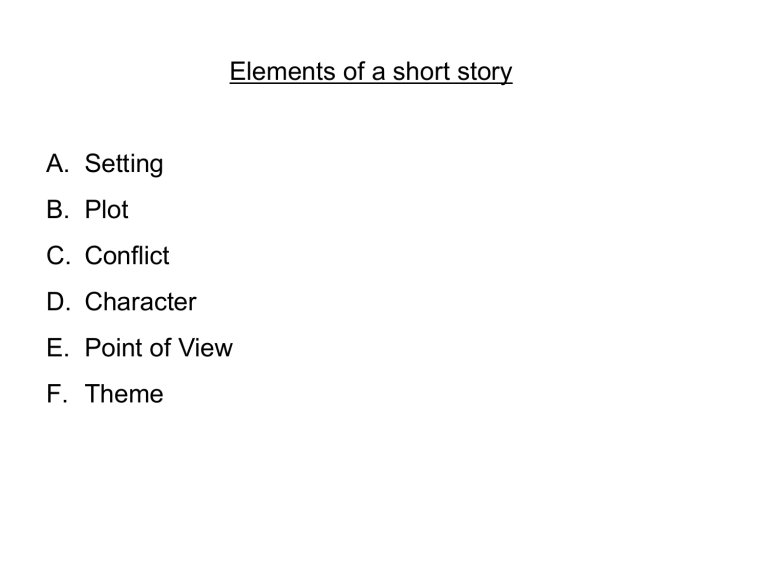
Elements of a short story A. Setting B. Plot C. Conflict D. Character E. Point of View F. Theme Elements of a short story A. Setting: The time and location in which a story takes place is called the Setting. For some stories the setting is very important, while for others it is not. There are several aspects of a story’s setting to consider when examining how setting contributes to a story 1. Place: Geographical Location. 2. Time: When is the Story taking place? 3. Weather Conditions: 4. Social Conditions: What is the daily life of the characters like. 5. Mood or Atmosphere: What is created at the beginning of the story? Elements of a short story B. Plot: The Plot is how the author arranges events to develop the basic idea; it is the sequence of events in the story. The plot is a planned, logical series of events having a beginning, middle, and end. There are five essential parts of plot: 1. Introduction: The beginning of the story where the characters and setting are revealed. 2. Rising Action: This is when the events in the story become complicated and the conflict in the story is revealed. Elements of a short story B. Plot: 3. Climax:this is the highest point of interest and the turning point of the story. The reader wonders what will happen next; will the conflict be resolved or not. 4. Falling Action: The events and complications begin to resolve themselves. The reader knows what has happened next and if the conflict was resolved or not. 5. Denouement: This is the final outcome or untangling of events in the story. Elements of a short story C. Conflict: Conflict is essential to plot. Without conflict there is no plot. It is the opposition of forces which ties one incident to another and makes the plot move. Conflict is not merely limited to open arguments, rather it is any form of opposition that faces the main character. Within a short story there may be only one central struggle, or there may be one dominant struggle with many minor ones. There are two types of conflict: 1. External: A struggle with a force outside of one’s Self. 2. Internal: A struggle within one’s self; a person must make some decision, overcome pain, quiet their temper, resist an urge, etc. Elements of a short story C. Conflict: There are Four Kinds of conflict: 1. Man v Man: (Physical) the leading character struggles with his physical strength against other men, forces of nature, or animals 2. Man v Circumstances: (Classical) The leading character struggles against fate, or the circumstances of life facing him. 3. Man v Society: (Social) The leading character struggles against ideas, practices, or customs of other people 4. Man v Himself: (Psychological) The leading character struggles with himself; with his own soul, ideas of right or wrong, physical limitations, choices, etc.. Elements of a short story D. Character: There are two meanings for the word “character”: 1. The person in a work of fiction. A. One character is clearly central to the story with all major events having some importance to this character - he is the Protagonist. B. The character who opposes the protagonist is called the Antagonist. Elements of a short story D. Character: There are two meanings for the word “character”: 2. The characteristics of a person. In order for a story to seem real to the reader its characters must seem real. Characterization is the information the author gives the reader about the characters themselves. The author may reveal a character in several ways: 1. His/her physical appearance 2. What he/she says, thinks, feels and dreams 3. What he/she does or does not do 4. What others say about him/her and how others react to him/her Characters are convincing if they are: consistent, motivated, and life-like elements of a short story D. Character: Characters are… 1. Individual: Round--many sided complex personalities 2. Developing: Dynamic--many sided personalities that change, for better or worse, by the end of the story. 3. Static: Stereotype--have one or two characteristics that never change and are emphasized Elements of a short story E. Point of View: Point of View, or P.O.V. is defined as the angle form which the story is told 1. Innocent Eye - The story is told through the eyes of a child (his/her judgment being different from that of an adult) . 2. Stream of Consciousness - The story is told so that the reader feels as if they are inside the head of one character and knows all their thoughts and reactions. elements of a short story E. Point of View: Point of View, or P.O.V. is defined as the angle form which the story is told 3. First Person - The story is told by the protagonist or one of the characters who interacts closely with the protagonist or other characters (using pronouns I, me, we, etc). The reader sees the story through this person's eyes as he/she experiences it and only knows what he/she knows or feels. elements of a short story E. Point of View: Point of View, or P.O.V. is defined as the angle form which the story is told 4. There are two main types of Third Person point of view: A. Omniscient Limited - The author tells the story in third person (using pronouns they, she, he, it, etc). We know only what the character knows and what the author allows him/her to tell us. We can see the thoughts and feelings of characters if the author chooses to reveal them to us. B. Third Person Objective - The author tells the story in the third person. It appears as though a camera is following the characters, going anywhere, and recording only what is seen and heard. There is no comment on the characters or their thoughts. No interpretations are offered. The reader is placed in the position of spectator without the author there to explain. The reader has to interpret events on his own. Elements of a short story E. Point of View Point of View, or P.O.V, is defined as the angle from which the story is told. 5. Second Person -- the story is told to another character using the pronouns you, your, and yours. It is not often used in fiction writing, but is used in letters, speeches, and other forms of nonfiction. Elements of a short story f. Theme: The theme in a piece of fiction is its controlling idea or its central insight. It is the author's underlying meaning or main idea that he is trying to convey. The theme may be the author's thoughts about a topic or view of human nature. The title of the short story usually points to what the writer is saying and he may use various figures of speech to emphasize his theme. such as: symbol, allusion, simile, metaphor, hyperbole, or irony. Some simple examples of common themes from literature, TV, and film are: 1. Things are not always as they appear to be 2. Love is blind 3. Believe in yourself 4. People are afraid of change 5. Don't judge a book by its cover

